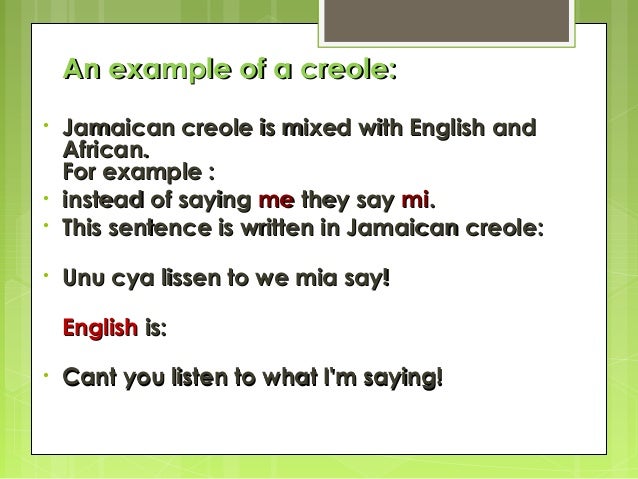
It’s a complication you don’t usually need to be told whether the person you’re talking about is a male or female. But many languages in the world do not distinguish between ‘he’ and ‘she’. The average English speaker thinks of gender as integral to language.

Native American Pidgin English discarded gender, and used he/him for all. In fact, this is an example of how pidgins tend to leave out the complicated stuff, such as gender. However, notice, the business of the squaw being ‘he’ does not represent some sort of advanced conception of gender relations. He says, “Look squaw in face-see him smile-which is all one he say yes!” The ‘all one’ is ‘like’, to indicate that the ‘squaw’ says yes. The Indifference to Gender in Native American Pidgin EnglishĪnother passage of this pidgin is from a male Native American, who is giving some sort of pick-up advice. However, it’s also articulate in its way.
#Example of pidgin english full#
Of course, this short speech does not represent the full battery of expression in the English language. That’s pretty mean, but that is American Indian Pidgin English. That came from the Narragansett language of Rhode Island it was common across the country for Native Americans when speaking in English to refer to women as ‘squaws’.Īnother example is a quote from a female Native American, who is trying to insult or abuse a white man: “You silly. Let’s take the example of the word ‘squaw’ used for ‘woman’. Examples of Native American Pidgin English For example, ‘heap’ was used for ‘very’ so, ‘heap big tee-pee’ was something that Native Americans actually said. There were conventions in this American Indian Pidgin English that you could see across the country. It wasn’t just a bunch of Native Americans speaking English incorrectly. Of course, nobody put it that way, but, looking back on the documentation, there was an American Indian Pidgin English. Thus, many Native Americans, up until the 1800s, in particular, tended to communicate with the white man in pidgin English. The Origin of Native American Pidgin English They were intent on keeping their languages and cultures-and their folk ways-and communicating with the Europeans was something that they wanted to do on a makeshift basis.


However, as time went on, the whites proliferated and the Native Americans became the subordinate group.Īs we would expect, most Native Americans, until their almost complete acculturation, were not inclined to become Europeans. Initially, the Native Americans outnumbered white Europeans. The continent was populated by hundreds of different groups of Native Americans-till the Europeans came. Tonto is always shown to be no more than two feet away from him and, somehow, he always spoke a type of pidgin. The Lone Ranger spoke, very strangely for his social status, a rather unusually pristine mainstream educated English.

What was interesting was that Tonto and the Lone Ranger, by implication, were together all the time. Ugh.” That was just kind of accepted.Īnd, it wasn’t always a Bugs Bunny joke, either, because Tonto, on The Lone Ranger was depicted as speaking that way. Hollywood often shows the Native Americans talking in a certain way, which we are now all familiar with: “Big chief go that way. A typical example of this was the Native American Pidgin English that developed in America back in the early days. So, it’s more the subordinate group learning the dominant group’s language than the other way around. Usually, pidgin languages form in situations where there is subordination between groups.


 0 kommentar(er)
0 kommentar(er)
